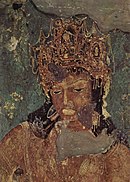Devasena (Vakataka king)
| Devasena | |
|---|---|
| Reign | c. 450 – c. 475 CE |
| Successor | Harishena |
| House | Vakataka dynasty |
|
Vakataka dynasty 250 CE–500 CE |
|
 |
 |
| Vindhyashakti | (250–270) |
| Pravarasena I | (270–330) |
| Pravarapura–Nandivardhana branch | |
| Rudrasena I | (330–355) |
| Prithivishena I | (355–380) |
| Rudrasena II | (380–385) |
| Prabhavatigupta (regent) | (385–405) |
| Divakarasena | (385–400) |
| Damodarasena | (400–440) |
| Narendrasena | (440–460) |
| Prithivishena II | (460–480) |
| Vatsagulma branch | |
| Sarvasena | (330–355) |
| Vindhyasena | (355–400) |
| Pravarasena II | (400–415) |
| Unknown | (415–450) |
| Devasena | (450–475) |
| Harishena | (475–500) |
Devasena (r. c. 450 – c. 475 CE) was a king of the Vatsagulma branch of the Vakataka dynasty. He was succeeded by his son Harishena who was notable for his patronage of the Ajanta caves. His daughter was wed to the Vishnukundin monarch, Madhavavarman II Janashraya.
Cave 16 at Ajanta credits Varahadeva, a minister of Harishena, as its patron and records the genealogy of Harishena as well as a description of Varahadeva and his father, Hastibhoja. As Varahadeva served his king, Hastibhoja served Devasena. Hastibhoja was entrusted with the responsibility of administering the kingdom while Devasena contented himself with the pursuit of pleasure.
The Hisse-Borala stone inscriptions note that a tank named Sudarshana was created by a Svamilladeva, an official under Devasena.
...
Wikipedia
